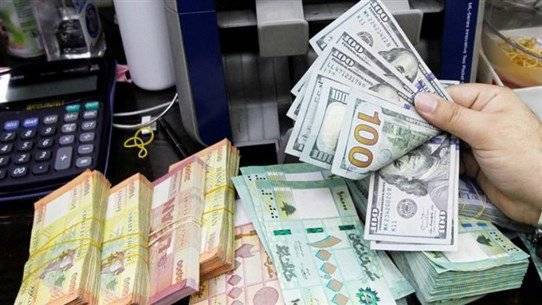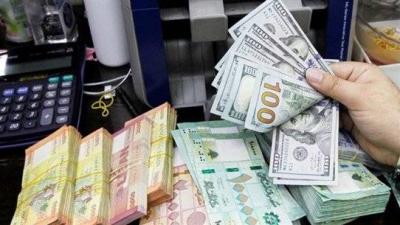The statement by Finance Minister Youssef Khalil regarding the adjustment of the exchange rate to 15,000 lira per dollar, instead of 1,507 lira, has caused significant confusion, prompting the Ministry of Finance to issue a corrective statement canceling the scheduled implementation of the new exchange rate at the end of October 2022, postponing it until a recovery plan is approved. The confusion arose because Khalil's comments regarding the new exchange rate lacked clarity about the implications; adjusting the exchange rate has obligatory effects on all contracts in Lebanon (commercial, labor, housing, debts), not limited solely to tax purposes. Consequently, the ambiguity around such an issue will leave considerable room for interpretation and may lead to unrest.
It has become clear that the initial statement from the Ministry of Finance, based on Articles 75 and 83 of the Monetary and Credit Law, seeks to transfer a significant portion of the losses accumulated in the balance sheet of the Central Bank of Lebanon, or that which will accumulate in the future due to the buying and selling of dollars directly with the public, to the treasury, effectively financing these losses with public money. Additionally, there appears to be another goal: to place the responsibility of all the losses in the Central Bank’s balance sheet related to defending the stability of the exchange rate (averaging 1,507.5 lira) over a period exceeding 22 years on successive governments. It seems that the governor, Riad Salameh, has tried on multiple occasions to assert that he is not the party that set the fixed exchange rate, but rather the government, and that he defends policies approved by it. In this sense, the adjustment of the exchange rate to become 15,000 lira originated from the government and the Parliament, making its defense a duty of the “Central Bank” while transferring the losses to the treasury. Thus, the governor gains legal cover for the dissipation of billions from the early 1990s until today.
Regardless of the goals, this adjustment in the exchange rate has mandatory power that extends from "tax calculation purposes in the budget" to the economy and society. Over the past months, discussions regarding the customs dollar have intensified, as it represents a key resource for the treasury which now faces additional salary obligations to public sector employees that cannot be met without additional financial collection. One of the most prominent sources for this collection is the customs fees imposed on imported goods. The fee is deducted based on the value of the imported commodity in foreign currency, and the foreign currency exchange rate of 1,507.5 lira no longer seems logical, necessitating an adjustment. Thus, the discussion was limited to the customs dollar price. Suddenly, it began to encompass all taxes. For instance, the dollar price for Value Added Tax (VAT) collection will automatically be adjusted because a significant portion of it is deducted along with the customs fees during the importation of goods. However, regarding other taxes and fees, such as the financial stamp, property tax, and taxes on contracts and their registration at the Ministry of Finance, all of them will be based on an exchange rate of 15,000 lira. In this regard, the value of taxes and fees will increase based on a single standard: the exchange rate, without any consideration for the economic functions these taxes perform within society. The value of property estimations, commercial transactions, and the value of property rights... Everything contracted in dollars between private parties will be subject to the new exchange rate. But what if there are agreements made at multiple exchange rates like those currently in place? Are there not contracts based on the rate of bank checks? Are there not contracts stating the applicable exchange rate? Are there not contracts in cash dollars? Thus, any mismanagement in organizing the transition process accurately, effectively, and comprehensively could lead to problems and unrest, especially given the absence of a judiciary to settle these matters. Notably, the judiciary itself, which has yet to define its stance on operating with contracts and the exchange rate, will face a new layer of complexity if it seeks to adjudicate disputes.
Nevertheless, sources within the Ministry of Finance state that implementation will proceed at the end of October as scheduled. They add that all contracts in foreign currency will be subject to this adjustment concerning tax assessments, including income tax, profit tax, distribution tax, financial stamp fees, and other taxes and fees. "However, regarding the application of this matter to financial institutions, i.e., banks, it falls to the Central Bank of Lebanon, which will issue regulations organizing the matter. Everything related to loan contracts, deposits, and others will be organized within the Central Bank, especially since the Central Bank is consulting with the Minister of Finance based on Article 75 of the Monetary and Credit Law to determine the exchange rate at 15,000 lira." According to sources, the regulatory mechanism remains unclear, although there are expected steps such as raising the bank dollar price to 15,000 lira and increasing loan repayment prices... However, everything related to preparing bank budgets, and its effects on their capital and own funds will be determined by the Central Bank.
So, what can we expect from Central Bank Governor Riad Salameh? There is not much to expect, but what is clear so far is that the decision to determine and agree on an exchange rate has not been presented, even for informational purposes, to the Central Council of the Central Bank. The Central Council itself comprises political puppets who tirelessly advocate for Salameh's continuity in office within the framework he has outlined for distributing losses and restructuring the banking system. These puppets are not limited to the Central Council, as there are similar figures in the Banking Control Committee, the Higher Banking Authority, and all other institutions headed by Salameh in his capacity as Governor of the Central Bank. Therefore, there is little trust in these puppets; meanwhile, the course mandated by Salameh has become clear and known: imposing exchange rate plurality to allow for the cancellation of part of the deposits and then covering withdrawals from frozen deposits through cash injections. Both actions lead to a continuous increase in the exchange rate, especially since no capital control law has been established, with the resulting inflation in prices necessitating printing more lira, which is then re-utilized within the same objective, further feeding the rise in the exchange rate... and thus inflation, and so on. This cycle has persisted for three years.
In the meantime, it remains unclear whether Salameh genuinely aims to restructure the banking sector or whether he prefers a "zombie" sector until the end of his term and his departure. For instance, let's consider what he is doing at the Higher Banking Authority to which five banks have been referred for severe administrative or financial reasons, or for both combined. To date, no decision has been made to take control of any bank or appoint an interim manager; instead, rescue operations are being negotiated regarding "Fedaral Bank", with sources indicating that the Central Bank intends to lend it two million dollars monthly to save it from bankruptcy!
With the adoption of an exchange rate of 15,000 lira, the impact on the banks' budgets will be significant. Some sources suggest that the study by the Banking Control Committee indicates a sweeping loss of most banks' capital at this rate, while other sources cite that 10 billion dollars of banks' capital will vanish directly. If we account for the losses from banks' investments at the Central Bank, the following becomes evident: banks have around 80 billion dollars (in foreign currency) invested in the Central Bank, yet the latter has no coverage in foreign currency exceeding 25 billion dollars (including gold valuation), meaning that the losses from these investments approximate 55 billion dollars.
So, what kind of rescue will Salameh provide through his regulations, other than maintaining his previous scheme to inject liquidity and extinguish his and the banks’ losses, loading them onto society? Another option he may pursue is to extinguish losses by transferring state assets and state ownership to banks and major depositors at a low price. This option is being advanced through a draft law for banking sector restructuring and the creation of a deposit fund financed by revenue from state assets!
Will the "unified price" trick fool the IMF? When Finance Minister Youssef Khalil stated that he would adopt, in agreement with the Central Bank, an exchange rate of 15,000 lira per dollar, some promoted it as a unification of the exchange rate that aligns with what the IMF demands from Lebanon as a precondition for a final agreement. But will this trick convince the Fund? In reality, there are levels of response; first, that the Central Bank has adopted the “Sayrafa” platform price as the closest to the market, and that it is a variable price, contrary to the idea of taxing within the general budget at a fixed rate of 15,000. Secondly, alongside the “Sayrafa” price, there exists the free market price, the deposit price according to Circular 151 (8,000 lira per dollar), and the deposit price based on Circular 158 (12,000 lira per dollar), meaning that abolishing “Sayrafa” and unifying the circulars to make all deposits and taxes at the rate of 15,000 lira does not unify the exchange rate, but rather, places the free market price at two and a half times higher than the 15,000 lira rate. Thus, instead of getting closer to the free market price, it has distanced itself significantly from it. Thirdly, there is no doubt that unifying the exchange rate begins with a more solid step than issuing a statement or even a news agency announcement; it should be a well-declared monetary policy consistent with a clear economic direction and clearly defined goals.
For these reasons, no one expects this trick to fool the IMF, as it is not a unification of the exchange rate, and it amounts to nothing more than steps whose transparency and objectives are questionable.




